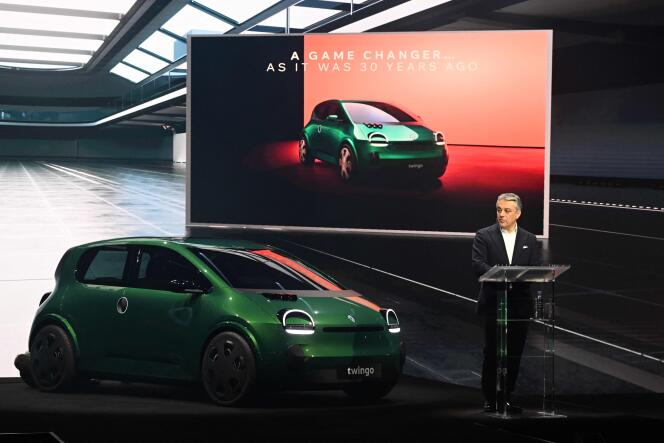For the launch of Ampere, Wednesday November 15, the new Renault subsidiary entirely dedicated to electric vehicles, the group’s general director, Luca de Meo, absolutely wanted to present his future model at 20,000 euros (excluding subsidies). A low-cost car, but connected and desirable, and not just any car: a Twingo, an emblematic model of the 1990s, with which he began his career at Renault.
In just a few months, Laurens van den Acker, the design boss of the French car manufacturer, and Gilles Vidal, that of Ampere, ex-star of Peugeot, designed and produced a model of the future car, a little longer than the original from 1992, but just as offbeat and successful. A nod to the first model, nicknamed the “frog”, it is green! “And very close to what the finished car will be”, promises Gilles Vidal. It still has its half-moon headlights (but LED this time) and round door handles.
As Jean-Michel Normand, journalist at WorldIn These cars that tell us (Editions Epa, 240 pages, 29.95 euros), a beautiful illustrated book, the Twingo was perfectly suited to “a stubborn economic languor” and to a “tired consumer society”. Hence its success, particularly among seniors looking for a “elixir of youth”.
In a gloomy economic and environmental context, will Luca de Meo pull off the same feat? With this car, planned for 2026, in just over two years, it first wants to show that its subsidiary Ampere can release a new model in record time. And that it can be produced in Europe.
The Twingo must “democratize electric vehicles in Europe. We will therefore reduce our costs significantly to reduce prices, while improving the margin,” underlines Thierry Piéton, the financial director of Renault. It relies on technology, with simpler and more efficient batteries, and electronics, developed with Qualcomm and Google, two Ampere partners, which reduces the microprocessors in the vehicle from 80 to five.
Luca de Meo: “The factories in France are full”
Furthermore, nine hours are enough to assemble an electric vehicle, three times less time than for a thermal vehicle. Finally, “we don’t need to spend millions of euros on advertising to make the names of R5, 4L or Twingo known”, adds Luca de Meo: they are already part of the heritage. The general director even estimated “80 million euros since 2021 the impact in terms of public relations” of its decision to relaunch the R5, expected at the next Geneva Motor Show. “The Twingo is our response to decarbonization, the reindustrialization of Europe and purchasing power”assures the manager.
You have 45% of this article left to read. The rest is reserved for subscribers.
